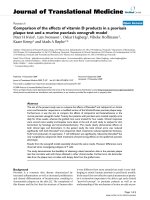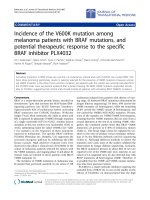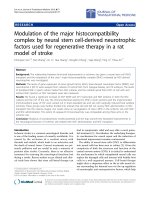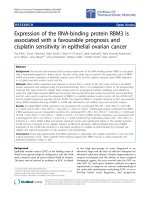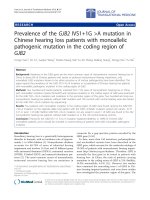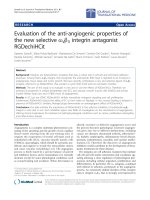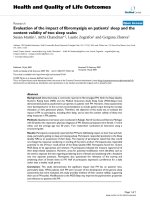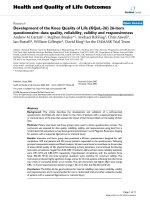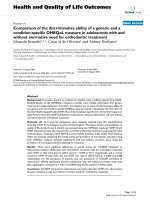báo cáo hóa học: " Reliability of the biceps brachii M-wave" ppt
Bạn đang xem bản rút gọn của tài liệu. Xem và tải ngay bản đầy đủ của tài liệu tại đây (846.3 KB, 8 trang )
BioMed Central
Page 1 of 8
(page number not for citation purposes)
Journal of NeuroEngineering and
Rehabilitation
Open Access
Research
Reliability of the biceps brachii M-wave
Kristina M Calder, Lesley-Ann Hall, Steve M Lester, J Greig Inglis and
David A Gabriel*
Address: Electromyographic Kinesiology Laboratory, Faculty of Applied Helath Science, Brock University, 500 Glenridge Avenue, St.Catharines,
Ontario, L2S 3A1 Canader
Email: Kristina M Calder - ; Lesley-Ann Hall - ; Steve M Lester - ;
J Greig Inglis - ; David A Gabriel* -
* Corresponding author
Compound muscle action potentialintraclass correlation coefficientelectromyographic activity
Abstract
Background: The peak-to-peak (P-P) amplitude of the maximum M-wave and the area of the
negative phase of the curve are important measures that serve as methodological controls in H-
reflex studies, motor unit number estimation (MUNE) procedures, and normalization factors for
voluntary electromyographic (EMG) activity. These methodologies assume, with little evidence,
that M-wave variability is minimal. This study therefore examined the intraclass reliability of these
measures for the biceps brachii.
Methods: Twenty-two healthy adults (4 males and 18 females) participated in 5 separate days of
electrical stimulation of the musculocutaneous nerve supplying the biceps brachii muscle. A total
of 10 stimulations were recorded on each of the 5 test sessions: a total of fifty trials were used for
analysis. A two-factor repeated measures analysis of variance (ANOVA) evaluated the stability of
the group means across test sessions. The consistency of scores within individuals was determined
by calculating the intraclass correlation coefficient (ICC). The variance ratio (VR) was then used to
assess the reproducibility of the shape of the maximum M-wave within individual subjects.
Results: The P-P amplitude means ranged from 12.62 ± 4.33 mV to 13.45 ± 4.07 mV across test
sessions. The group means were highly stable. ICC analysis also revealed that the scores were very
consistent (ICC = 0.98). The group means for the area of the negative phase of the maximum M-
wave were also stable (117 to 126 mV·ms). The ICC analysis also indicated a high degree of
consistency (ICC = 0.96). The VR for the sample was 0.244 ± 0.169, which suggests that the biceps
brachii maximum M-wave shape was in general very reproducible for each subject.
Conclusion: The results support the use of P-P amplitude of the maximum M-wave as a
methodological control in H-reflex studies, and as a normalization factor for voluntary EMG. The
area of the negative phase of the maximum M-wave is both stable and consistent, and the shape of
the entire waveform is highly reproducible and may be used for MUNE procedures.
Published: 06 December 2005
Journal of NeuroEngineering and Rehabilitation 2005, 2:33 doi:10.1186/1743-0003-2-33
Received: 28 December 2004
Accepted: 06 December 2005
This article is available from: />© 2005 Calder et al; licensee BioMed Central Ltd.
This is an Open Access article distributed under the terms of the Creative Commons Attribution License ( />),
which permits unrestricted use, distribution, and reproduction in any medium, provided the original work is properly cited.
Journal of NeuroEngineering and Rehabilitation 2005, 2:33 />Page 2 of 8
(page number not for citation purposes)
Background
The massed action potential (M-wave) is known as the
compound muscle action potential (CMAP); it is an
important investigative tool in several different areas of
neurophysiological research. Evoking the maximum M-
wave (M
max
) by supramaximal stimulation is the electrical
equivalent of the recruitment of all motor units within the
motor neuron pool [1]. The M
max
is a methodological
control to ensure that the effective stimulus intensity to
peripheral nerves is consistent across recording sessions
[2]. Using a stimulus intensity that produces M-wave
responses corresponding to a consistent percentage of
M
max
ensures that the same numbers of motor axons are
recruited in each trial [3].
The area of the negative phase of the maximum M-wave is
a critical part of motor unit number estimation for track-
ing the progression of neuromuscular disorders [4]. The P-
P amplitude of the maximum M-wave is used in Hoffman
reflex (H-reflex) studies to accurately conclude that varia-
tions in the H-reflex arise from a neural origin, and are not
caused by changes in the muscle, recording conditions, or
problems with instrumentation [3]. This is accomplished
by calculating the ratio between the maximum P-P ampli-
tude of the H-reflex and the M-wave (H
max
/M
max
), which
is considered an index of excitability of the H-reflex arc
[1,3,5]. Similarly, the M-wave is also used as a normaliza-
tion factor to correct for day-to-day fluctuations in volun-
tary electromyographic (EMG) activity due to slight
differences in electrode placement, muscle temperature,
and other such considerations [6,7].
The methodologies described above are based on the
assumption that there is little variability in the M-wave.
Given the importance of the M-wave as a clinical and
investigative tool, there are surprisingly few studies that
have documented the variability of this waveform. Studies
thus far have only examined simple test-retest reliability
[4,8-10], and only one of these studies has included both
the P-P amplitude and the area of the negative phase of
the maximum M-wave [3]. Two studies have performed a
more comprehensive analysis of M-wave reliability using
the intraclass correlation coefficient (ICC), but neither the
P-P amplitude nor area of the negative phase of the maxi-
mum M-wave were specifically investigated [11,12]. The
purpose of this study was therefore to examine maximum
M-wave reliability using both the P-P amplitude and area
of the negative of the curve for responses obtained from
the biceps brachii muscle over a series of five test sessions.
Materials and methods
Subjects
A total of 22 healthy subjects participated in this study.
Table 1 provides data for the demographic characteristics
of the subjects. An informed consent form was read and
signed prior to participation, in accordance with Brock
University's human ethics.
Table 1: Physical characteristics of the subjects (N = 22) including gender, age, height, weight and body mass index (BMI).
Subject no. Gender Age (years) Height (m) Weight (kg) BMI (kg/m
2
)
1 F 24 1.70 68.04 23.49
2 F 28 1.70 62.60 21.61
3 F 22 1.56 66.68 27.40
4 F 25 1.60 47.00 18.36
5 F 27 1.60 72.12 28.17
6 F 21 1.68 68.04 24.21
7 F 31 1.63 49.90 18.88
8 F 20 1.58 56.70 22.86
9 F 22 1.65 53.52 19.64
10 F 22 1.68 52.16 18.56
11 F 22 1.73 56.70 19.01
12 F 18 1.75 66.68 21.71
13 F 19 1.70 58.97 20.36
14 F 22 1.68 72.58 25.71
15 M 18 1.82 82.56 24.92
16 F 27 1.78 76.20 24.05
17 F 20 1.65 56.25 20.66
18 F 20 1.61 46.27 17.85
19 M 29 1.83 97.07 28.99
20 F 22 1.71 58.97 20.17
21 M 26 1.96 104.33 27.16
22 M 20 1.72 67.00 22.65
Mean ± SD 22.87 ± 3.61 1.69 ± 0.09 65.05 ± 14.65 22.50 ± 3.35
Journal of NeuroEngineering and Rehabilitation 2005, 2:33 />Page 3 of 8
(page number not for citation purposes)
Measurement schedule and procedures
There were 5 days of testing with at least 24 hours between
each session. All testing was done on the right arm while
subjects lay prone on a gurney with their shoulder
abducted to 90° at their side, palm facing up with the
elbow slightly flexed. Prior to electrode placement, the
skin on the right upper arm was lightly abraded with and
cleaned with rubbing alcohol to reduce signal impedance
at the skin surface. The motor point was then determined
for electrode placement. The motor point is defined as the
region of the muscle where the lowest possible stimulus
will produce a minimal muscle twitch. The motor point of
the biceps brachii (BB) was located approximately mid-
way between the glenohumeral joint and the cubital
crease.
The cathode portion of the stimulating probe was placed
in the estimated motor point region. With the train rate
on the stimulator set at 10 pps, and the stimulus duration
set at 1 msec [13], the cathode was moved around the
muscle belly to find the motor point. Prior to placing the
recording (G2) and reference (Gl) electrodes, skin imped-
ance was measured (Grass EZM Electrode Impedance
Meter, Astro-Med Inc., Warwick, RI) and maintained
below 10 kΩ. The G2 electrode was placed directly above
the motor point of the BB muscle. The Gl electrode was
placed on the biceps tendon. Both Gl and G2 were stand-
ard size (20 mm diameter) Ag/AgCl electrodes (Grass F-
E9-40-5, Astro-Med Inc., Warwick, RI). A self-adhesive
ground electrode was placed on the upper portion of the
biceps muscle, between G2 and the point of stimulation
on the musculocutaneous nerve. The EMG system (Grass,
P511, Astro-Med Inc., W Warwick, RI) amplified the
evoked potentials (1000×) before they were band-passed
filtered (3–1000 Hz).
The M-wave was evoked with a cathode placed in the axil-
lary fold over the musculocutaneous nerve (see Figure 1).
The cathode and anode electrodes were connected in
series with an isolation unit (Grass Telefactor SUI8, Astro-
Med, Inc., West Warwick, RI) and a stimulator (Grass Tel-
efactor S88, Astro-Med Inc., West Warwick, RI) that deliv-
ered a square-wave pulse, 1 msec in duration [13].
To ensure that electrical stimulation was accurately over
the musculocutaneous nerve, and that the BB was the only
muscle being activated, bipolar surface electrodes (DE-
2.1, Delsys Inc., Boston, MA) were positioned over the
biceps and triceps brachii. One electrode was placed on
the lower third of the biceps belly, below the motor point
towards the distal tendon. The other was placed between
the distal tendon and the top of the belly of the triceps lat-
eral head to monitor activity in the antagonist muscles. A
self-adhesive ground electrode was also secured over the
Experimental set-up for stimulation at the musculocutaneous nerve to record maximum M-wave responses from the biceps brachii muscleFigure 1
Experimental set-up for stimulation at the musculocutaneous nerve to record maximum M-wave responses from the biceps
brachii muscle.
Journal of NeuroEngineering and Rehabilitation 2005, 2:33 />Page 4 of 8
(page number not for citation purposes)
collarbone. These signals were amplified with a fixed gain
of 10 at the skin surface. The EMG system (Bagnoli 4, Del-
sys Inc., Boston, MA) further amplified the signals (100×)
before they were band-passed filtered (20–450 Hz). Elec-
trode placement remained consistent by tracing all sites
with indelible ink, and asking participants to preserve
these markings for the duration of the study.
All signals were sent to a 16-bit A/D converter (BNC-2110,
National Instruments), and sampled at 2048 Hz using a
Computer-Based Oscillograph and Data Acquisition Sys-
tem (DASYLab, DASYTEC National Instruments,
Amherst, NH). This recorded data was stored for further
analysis on a Pentium III PC (Seanix Technology Inc.,
Blaine, WA).
Stimulation protocol
Subjects were instructed to close their eyes and lay still
throughout the session. The BB M-wave was obtained by
stimulating the musculocutaneous nerve as depicted in
Figure 1. Stimulations started below the response thresh-
old, and increased in 4 V increments until M
max
was
achieved. Stimulus intensity was then increased slightly
beyond this point to confirm no further enlargement in
the peak-to-peak amplitude, and subsequently returned
to the lower intensity where the M response remained sta-
ble [14,15]. Ten stimuli were delivered, separated by a 15-
second rest after each pulse. The M-waves were recorded
for each trial and saved for later analysis. This protocol
was followed for each of the 5 days of testing.
Data reduction
Data reduction was conducted for all ten trials for each of
the five test sessions. The P-P amplitude of the biceps bra-
chii M-wave was calculated as the difference between the
maximum and minimum of the signal. Area of the nega-
tive phase of the biceps brachii M-wave was calculated
using trapezoidal integration:
where n is the number of data points, y
i
is the data value
at time t, and ∆t is the sampling interval. The start of the
negative phase of the biceps brachii M-wave was defined
as the first point to cross the zero baseline after the stimu-
lus artefact (t
1
, y
1
). The end of the negative phase of the
biceps brachii M-wave was the last point before the sec-
ond baseline crossing (t
n
, y
n
). Since trapezoidal integra-
tion is sensitive to interval width (∆t), the entire waveform
was interpolated to a sampling rate of 10 kHz prior to cal-
culating area under the curve [11]. All data reduction was
completed using MATLAB software (The Mathworks Inc.,
Natick, MA).
Analysis
All statistical procedures were performed in SYSTAT (SPSS
Inc., Chicago, IL). A significance level of P <0.05 was
adopted for this study.
Intraclass correlation analysis of variance
Reliability analysis with the intraclass correlation coeffi-
cient (ICC) requires two different analysis of variance
(ANOVA) models [15-18]. One is to establish the "con-
sistency" of the measures. This is a fully nested model
wherein trials are nested within days, which are in turn
nested within subjects. When subjects are able to repro-
duce their own score, the scores are tightly group around
the subject's own mean. In this way, the scores of one sub-
ject are very different from the scores of another, and the
between subjects means squares (MS) error is high. This is
also reflected as a high true score variance (σ
2
True
), as out-
lined below. Measures that are highly reliable have a true
score variance that accounts for the greatest percentage of
the total variance. The second ANOVA model is used to
examine the "stability" of the means across test sessions.
This ANOVA model has two factors (days × subjects). The
repeated measurements (trials) on each subject in each
day constituted a "within-cells" replication of measures
[15-18]. A measure must therefore exhibit both consist-
ency and stability to be considered reliable. The ICC was
calculated in the following way:
The mean square (MS) errors for subjects, days and trials
were extracted from the fully nested ANOVA model to cal-
culate the ICC in equation 2. In equations 3–5, a' is
number of days, n' is number of trials, σ
2
e2
is error vari-
ance due to days, σ
2
e1
is error variance due to trials, and
σ
2
true
is the true score variance. The total variance σ
2
Total
was then calculated as the sum of the variances (σ
2
true
+
σ
2
e1
+ σ
2
e2
). The portion of variances attributable to day-
to-day (σ
2
e2
/σ
2
Total
), trial-to-trial (σ
2
e1
/σ
2
Total
), and
between subjects (σ
2
True
/σ
2
Total
) error were computed to
identify the amount of variability at each level of measure-
ment [11,12].
y(t)dt =
yy
t, 1
i1 i
i=1
n
t
t
1
n
−
+
∆
()
∑
∫
2
ICC=
a’ a’ n’
true
true
ee
21
σ
σ
σσ
2
2
22
++
⋅
()
2
σ
2
e
MS
1
Trials 3=
()
σ
2
e
MS MS
2
Days Trials
n’
=
−
()
4
σ
2
true
MS MS
Subjects Days
a’ n’
=
−
⋅
()
5
Journal of NeuroEngineering and Rehabilitation 2005, 2:33 />Page 5 of 8
(page number not for citation purposes)
Variance ratio
The ICC is a ratio of variance due to differences between
subjects (signal) to the total variability in the data (signal
and noise). Thus, the ICC is a relative measure of the abil-
ity to differentiate between individuals [19]. Since clinical
measures and normalization techniques are relative to the
individual, there is need for an additional measure that
assesses the reliability of the biceps brachii M-wave within
the individual. The variance ratio (VR) assesses the "repro-
ducibility" of waveform shape for an individual subject
[20,21]. The more similar in shape the waveforms are, the
variance ratio tends towards 0. The more dissimilar in
shape the waveforms are, the variance ratio tends towards
1.
To calculate the VR, the biceps brachii M-wave for each
subject had to be normalized in the time-domain to the
same number of data points. Only the negative and posi-
tive phases of the biceps brachii M-wave were analyzed.
The start of the negative phase of the biceps brachii M-
wave was defined as the first point to cross the zero base-
line after the stimulus artefact (t
1
, y
1
). The end of the pos-
itive phase biceps brachii M-wave was the last point
before the third baseline crossing (t
n
, y
n
). The waveform
between these two points was then interpolated up to
1000 data points (T = 1000). This was done for all 50
waveforms (N = 50) within a subject. The formula for cal-
culating the VR was:
where y
t,n
was the data point for the amplitude of the
biceps brachii M-wave at the time t. To calculate , the
biceps brachii M-wave was averaged across the 50 trials,
which was still a 1000 point waveform. The grand mean
was then a single number that represents the mean of
all data points across the 50 trials.
Results
The means, standard deviations, and F-ratios used to eval-
uate the stability of the P-P amplitude of the maximum M-
wave are presented in Table 2. The between-subjects main
effect was significant, as was the slight increase (4.3%) in
P-P amplitude across test sessions. The day × subjects
interaction term was also significant, indicating that not
all subjects exhibited the same magnitude of increase in P-
P amplitude across test sessions.
The consistency of the P-P amplitude for the maximum
M-wave was evaluated using the intraclass correlation
analysis of variance. Despite the slight lack of stability in
the group means, individuals exhibited remarkable con-
sistency across test sessions. When individual subjects
produce consistent scores, the differences between sub-
jects become evident, yielding a large between-subjects
main effect. The resulting between-subjects variability
(σ
2
True
) accounted for 91% of the total variance. This is a
prerequisite for high reliability. Figure 2 illustrates how
responses between subjects can be very different. At the
same time, subjects can exhibit remarkable consistency
over trials and across days. The percentage of the variance
attributed to trial-to-trial variability (σ
2
e1
) was 1%, which
was much lower than the 8% day-to-day variability (σ
2
e2
).
The ICC for the P-P amplitude was 0.98.
The between-subjects main effect was significant for the
area of the negative phase of the biceps brachii M-wave
(see Table 2). There was a significant main effect for days
VR=
yy
T(N
yy
TN
t,n t
n=1
N
t=1
T
t,n
n=1
N
t=1
T
−
()
−
−
()
−
()
∑∑
∑∑
2
2
1
1
6
)
,
y
t
y
Table 2: The means (M) and standard deviations (SD) and analysis of variance (ANOVA) F-ratios for peak-to-peak (PP) amplitude and
area of the negative phase of the biceps brachii maximum M-wave the for the ten trials across five days for all subjects (N = 22).
Days P-P Amplitude (mV) (M ± SD) Area (mV·ms) (M ± SD)
1 12.90 ± 4.64 125.8 ± 40.1
2 12.63 ± 4.25 122.6 ± 40.1
3 12.66 ± 4.22 122.7 ± 39.5
4 12.62 ± 4.33 117.1 ± 37.4
5 13.45 ± 4.07 126.0 ± 35.2
Minimum – Maximum 5.07 – 23.64 mV 33.7 – 208.9 mV·ms
Source of Variation df F F
Subjects 21 2120.52
†
1191.54
†
Day 4 64.68
†
39.57
†
Day × Subjects 84 31.74
†
29.732
†
Within Cell 990
†
Significant at the 0.01 level
Journal of NeuroEngineering and Rehabilitation 2005, 2:33 />Page 6 of 8
(page number not for citation purposes)
as the area measure was also 4 to 7% lower on Day 4 than
on any other day. The day × subjects interaction term was
significant, indicating that not all subjects exhibited same
pattern of change in the area measure across test sessions.
However, this slight lack of stability in group means was
compensated for by a high degree of consistency within
subjects. The between subjects variability (σ
2
True
)
accounted for 80% of the total variance, which is neces-
sary for a high ICC. The trial-to-trial variability (σ
2
e1
) was
5% while the day-to-day variability (σ
2
e2
) was three-fold
greater (15%). The resulting ICC was 0.96.
The VR for the sample was 0.244 ± 0.169, indicating that
the biceps brachii maximum M-wave shape was in general
very reproducible for each subject. There was of course a
range of VRs. The biceps brachii maximum M-wave shape
was less reproducible for some subjects than others, but
they were few (see Figure 3). Figure 4 presents the wave-
forms associated with the two extremes observed in this
study.
Discussion
The reliability the P-P amplitude and the area of the neg-
ative phase of the maximum M-wave was assessed for fifty
trials distributed equally across five test sessions. The P-P
amplitude of the maximum M-wave exhibited excellent
reliability (ICC = 0.98) and so did the area of the negative
phase of the maximum M-wave (ICC = 0.96). These high
ICC values are consistent with previous work from our
laboratory, on other muscle groups [14,15]. In the follow-
ing paragraphs we will discuss the theoretical implications
and practical application of our results.
The P-P amplitude of the maximum M-wave ranged from
12.62 ± 4.33 mV to 13.45 ± 4.07 mV across test days. Tay-
lor et al. [22] reported a mean of 13.4 ± 4.2 mV while All-
man and Rice [23] observed a mean of 15.3 ± 5.6 mV.
Thus, our results are well within the range of values found
in the literature. The area of the negative phase of the max-
imum M-wave is used for MUNE, but its value in absolute
units is seldom reported. To the best of our knowledge, no
comparative data exist for the biceps brachii. In this
respect, the current work contributes normative data to
the existing literature. Rutkove [24] reported a mean of
44.2 mV·ms for the abductor pollicis (thenar muscle)
while Boe et al. [4] observed a nearly identical value (44.5
mV·ms). The later research group [4] also found a mean
of 29.2 mV·ms for the first dorsal interosseus/adductor
pollicis muscle. The biceps brachii means observed here
ranged from 117.1 to 126.0 mV·ms. Given the large P-P
amplitude values and longer durations compared to
smaller muscles, the area values are quite reasonable.
The ICC analysis of variance technique resulted in a relia-
bility coefficient for the P-P amplitude of the maximum
M-wave that was excellent. A high reliability is obtained
when the between-subjects variance is substantially larger
than the variance in scores within subjects, and the vari-
ance of scores due to error is minimized. Individual sub-
jects in the present study exhibited highly consistent P-P
amplitude scores, so that the variation in scores between
subjects could be clearly observed. Thus, the high ICC
value indicates that the P-P amplitude of the maximum
M-wave was a reliable estimation of complete activation
of the associated the motoneuron pool. These findings
provide evidence that support the use of the P-P ampli-
tude of the maximum M-wave as a methodological stand-
ard against which other muscular responses, such as the
H-reflex or voluntary EMG can be assessed.
The area of the negative phase of the maximum M-wave
also exhibited excellent reliability for the same reasons as
P-P amplitude. The maximum M-wave represents com-
plete activation of the muscle associated with the stimu-
lated peripheral nerve [25]. In the absence of a
neuromuscular disorder, it should remain unchanged
over time as the number of α-motoneurons remains con-
stant [3]. It is unreasonable to expect that any physiologi-
cal measure would have perfect reliability, but an ICC of
0.96 does indicate that the area of the negative phase of
the maximum M-wave can be a stable and consistent
measure of the number of α-motoneurons. The results
presented here therefore support its use in MUNE.
To date, reliability studies on MUNE have utilized quite
limited statistical techniques. The Pearson correlation
coefficient and the t-test were combined to evaluate
MUNE values obtained on only two separate occasions
Sample M-wave recordings from the bicep brachii muscle for two subjectsFigure 2
Sample M-wave recordings from the bicep brachii muscle for
two subjects. Shown are the ten trials for each of the five
test sessions, for a total of fifty waveforms for each subject.
Journal of NeuroEngineering and Rehabilitation 2005, 2:33 />Page 7 of 8
(page number not for citation purposes)
[4,9]. Both methods combined are limited in that they are
still insensitive to the problem of consistency. One study
did use the CV to evaluate the consistency of individual
subjects, but the stability of the group means was not con-
sidered [26]. The current study presents a comprehensive
treatment of the reliability of the area of the negative
phase of the maximum M-wave. This is important as
MUNE is performed over multiple test sessions to moni-
tor the progression of neuromuscular disorders.
Other investigators have reported that trial-to-trial varia-
bility accounted for the lowest percentage of the total var-
iance [11,12]. The peripheral nerve was recruited by a
hand-held stimulator as would occur during clinical test-
ing [27]. The low trial-to-trial variability indicates that this
was not an issue in the present investigation. As might be
expected, multiple test sessions introduce additional
sources of error. There could be slight differences in the
position of the stimulating and recording electrodes,
changes in electrode-skin input impedance and/or muscle
temperature [11,12,27]. Limb position is also critical as it
alters position of the nerve relative to the skin surface,
making it harder or easier to evoke the potential [27].
Changes in muscle geometry relative to the skin surface
associated different limb positions can alter the shape of
the evoked potential [12,27]. The low day-to-day variance
observed in this study suggests that careful methodologi-
cal controls can minimize these potential sources of error.
The resulting ICC values are higher in the current work
versus previous publications [11,12]. The reason may be
due to fundamentally different methodologies. In addi-
tion to well-controlled electrode placement and method-
ology, there was a strict adherence to a well-documented
anatomic reference position and stimulation site for the
peripheral nerve. Stimulation of the peripheral nerve and
recording the response at the measured motor point are
key to obtaining crisp, reliable M-waves. Previous ICC
studies [11,12] use a non-clinical protocol. The two
papers [11,12] use electrical stimulation of the motor
point and recording the M-wave between the motor point
and distal tendon. The recorded M-wave is more suscep-
tible to distortions associated with temporal dispersion
and a contracting muscle; it could not be used for MUNE.
Figure 2 was used to illustrate the relative nature of the
ICC. Individual responses can have a certain degree of var-
iability, but, if differences between subjects can be
detected, the ICC will be high. Thus, the VR was included
in this study to assess reproducibility of M-wave shape for
individual subjects. There is no generally accepted deline-
ation of excellent or even acceptable ranges of VR as exists
with the ICC. Jacoboson et al. [21] reviewed the existing
literature and set an upper limit of 0.40 as the criteria
below which the same muscle group on the right and left
legs would exhibit symmetrical profiles for linear envelop
detected EMG during gait. In the current sample, two sub-
jects had a VR much greater than 0.40 while a third was
only slightly greater than 0.40. The remainder of the sam-
ple had VRs below 0.40. The results for the ICC and VR
taken together support the earlier observation of Merletti
et al. [11,12] that shape features of M-waves are so reliable
that visual identification of subjects is possible based on
their M-waves.
Conclusion
The results support the use of P-P amplitude of the maxi-
mum M-wave as a methodological control in H-reflex
Time-domain normalized maximum M-wave recordings from the bicep brachii muscle for two subjectsFigure 4
Time-domain normalized maximum M-wave recordings from
the bicep brachii muscle for two subjects. Shown are the ten
trials for each of the five test sessions, for a total of fifty
waveforms for each subject. The two sets of waveforms illus-
trate the extreme range of variance ratios observed in this
study.
The variance ratios (VR) for all 22 subjectsFigure 3
The variance ratios (VR) for all 22 subjects.
Publish with BioMed Central and every
scientist can read your work free of charge
"BioMed Central will be the most significant development for
disseminating the results of biomedical research in our lifetime."
Sir Paul Nurse, Cancer Research UK
Your research papers will be:
available free of charge to the entire biomedical community
peer reviewed and published immediately upon acceptance
cited in PubMed and archived on PubMed Central
yours — you keep the copyright
Submit your manuscript here:
/>BioMedcentral
Journal of NeuroEngineering and Rehabilitation 2005, 2:33 />Page 8 of 8
(page number not for citation purposes)
studies, and as a normalization factor for voluntary EMG.
The area of the negative phase of the maximum M-wave is
both stable and consistent, and the shape of the entire
waveform is highly reproducible and may be used for
MUNE procedures. The intraclass correlation analysis of
variance is necessary for establishing the reliability (stabil-
ity and consistency) of EMG waveform measures, but not
sufficient for investigating reproducibility of the EMG
waveform shape. The variance ratio demonstrated that the
shape of the biceps brachii maximum M-wave was very
reproducible for all but a few subjects. Such information
is important if the M-wave is to be used in tracking the
progression of neuromuscular disorders.
Acknowledgements
This study was supported by NSERC of Canada
References
1. Maffiuletti NA, Martin A, Babault N, Pensini M, Lucas B, Schieppati M:
Electrical and mechanical H
max
-to-M
max
ratio in power- and
endurance-trained athletes. J Appl Physiol 2001, 90:3-9.
2. Aagaard P, Simonsen EB, Andersen JL, Magnusson P, Dyhre-Poulsen
P: Neural adaptation to resistance training: changes in
evoked V-wave and H-reflex responses. J Appl Physiol 2002,
92:2309-2318.
3. Crone C, Johnsen LL, Hultborn H, Ørnes GB: Amplitude of the
maximum motor response (Mmax) in human muscles typi-
cally decreases during the course of an experiment. Exp Brain
Res 1999, 124:265-270.
4. Boe S, Stashuk DW, Doherty TJ: Motor unit number estimation
by decomposition-enhanced spike-triggered averaging: con-
trol data, test-retest reliability, and contractile level effects.
Muscle Nerve 2004, 29:693-699.
5. Scaglioni G, Ferri A, Minetti AE, Martin A, Van Hoeck J, Capodaglio P,
Sartorio A, Narci MV: Plantar flexor activation capacity and H
reflex in older adults: adaptations to strength training. J Appl
Physiol 2002, 92:2292-2302.
6. Carolan B, Cafarelli E: Adaptations in coactivation after isomet-
ric resistance training. J Appl Physiol 1992, 73:911-917.
7. Rich C, Cafarelli E: Submaximal motor unit firing rates after 8
wk of isometric resistance training. Med Sci Sport Exerc 2000,
32:190-196.
8. Jaberzadeh S, Scutter S, Warden-Flood A, Nazeran H: Between-
days reliability of H- reflexes in human flexor carpi radialis.
Arch Phys Med Rehabil 2004, 85:1168-1173.
9. Shefner JM, Jillapalli D, Bradshaw DY: Reducing intersubject vari-
ability in motor unit number estimation. Muscle Nerve 1999,
22:1457-1460.
10. Williams LRT, Sullivan SJ, Seaborne DE, Morelli M: Reliability of
individual differences for H-reflex recordings. Electromyogr Clin
Neurophysiol 1992, 32:42-49.
11. Merletti R, Lo Conte LR, Sathyan D: Repeatability of electrically-
evoked myoelectric signals from the human tibialis anterior
muscle. J Electromyogr Kinesiol 1995, 5:67-80.
12. Merletti R, Fiorito A, Lo Conte LR, Cisari C: Repeatability of elec-
trically-evoked EMG signals in the human vastus lateralis.
Muscle Nerve 1998, 21:184-193.
13. Pierrot-Deseilligny E, Mazevet D: The monosynaptic reflex: a
tool to investigate motor control in humans: interest and
limit. Clin Neurophysiol 2000, 30:67-80.
14. Christie A, Lester S, LaPierre D, Gabriel DA: Reliability of a new
measure of motoneuron excitability. Clin Neurophysiol 2004,
115:116-123.
15. Christie A, Inglis GI, Boucher JP, Gabriel DA: Reliability of the FCR
H-reflex. J Clin Neurophysiol 2005, 22:204-209.
16. Feldt LS, McKee ME: Estimation of the reliability of skill tests.
Res Quart 1958, 29:279-293.
17. Kroll W: Reliability of a selected measure of human strength.
Res Quart 1962, 33:410-417.
18. Lindquist EF: Design and analysis of experiments in psychology and educa-
tion Boston: Houghton Mifflin Company; 1956.
19. Weir JP: Quantifying test-retest reliability using the intraclass
correlation coefficient and the SEM. J Stren Cond Res 2005,
19:231-240.
20. Hershler C, Milner M: An optimality criterion for processing
electromyographic (EMG) signals relating to human loco-
motion. IEEE Trans Biomed Eng 1978, 5:413-420.
21. Jacobson WC, Gabel RH, Brand RA: Surface vs. fine-wire elec-
trode ensemble-averaged signals during gait. J Electromyogr
Kinesiol 1995, 5:37-44.
22. Taylor JL, Butler JE, Gandevia SC: Altered responses of human
elbow flexors to peripheral-nerve and cortical stimulation
during a sustained maximal voluntary contraction. Exp Brain
Res 1999, 127:108-115.
23. Allman BL, Rice CL: Incomplete recovery of voluntary isomet-
ric fatigue is not affected by old age. Muscle Nerve 2001,
24:1156-1167.
24. Rutkove SB: Pseudofacilitation: a temperature-sensitive phe-
nonmenon. Muscle Nerve 2000, 23:115-118.
25. Magladery JW, Porter WE, Park AM, Teasdall RD: Electrophysio-
logical studies of nerve and reflex activity in normal man. Bull
Johns Hopkins Hosp 1951, 88:499-519.
26. Simmons Z, Epstein DK, Borg B, Mauger DT, Kothari MJ, Shefner JM:
Reproducibility of motor unit number estimation. Muscle
Nerve 2001, 24:467-473.
27. Preston DC, Shapiro BE: Electromyography and Neuromuscular Disor-
ders: Clinical-Electrophysiologic Correlations Boston: Butterworth-Heine-
mann; 1998.

